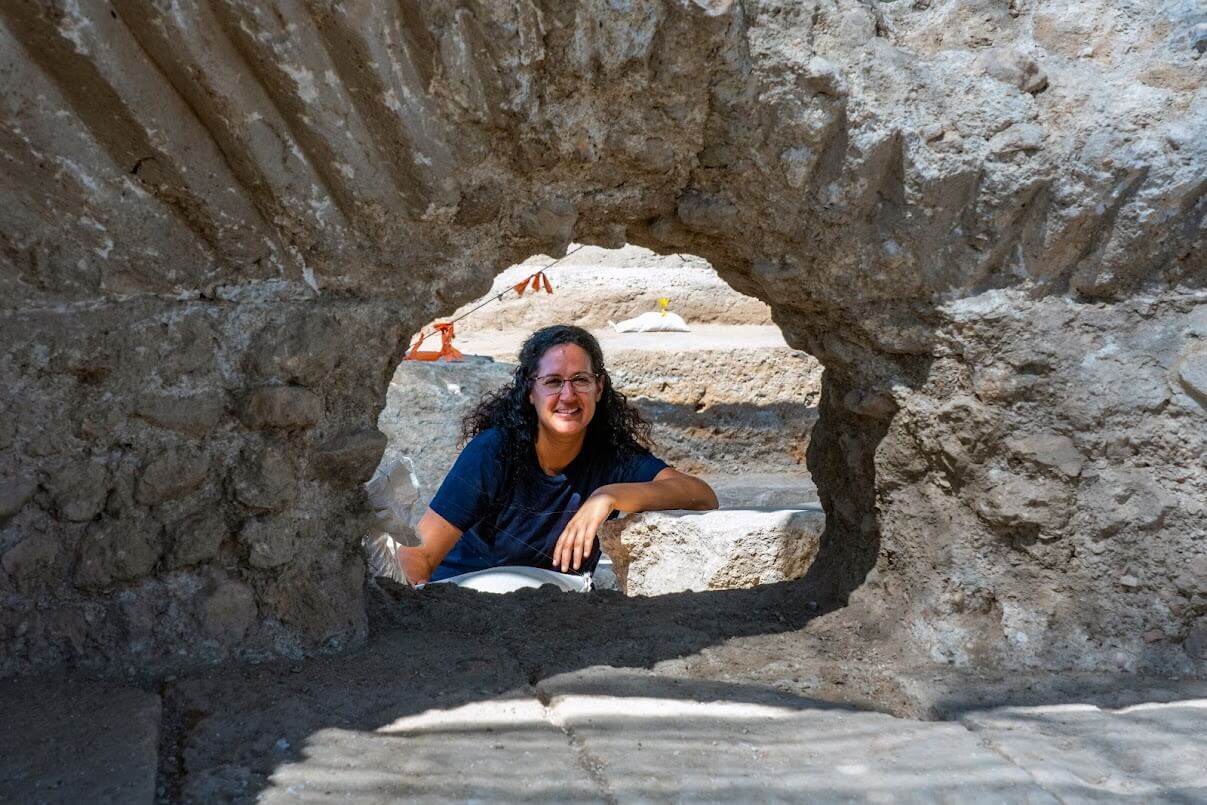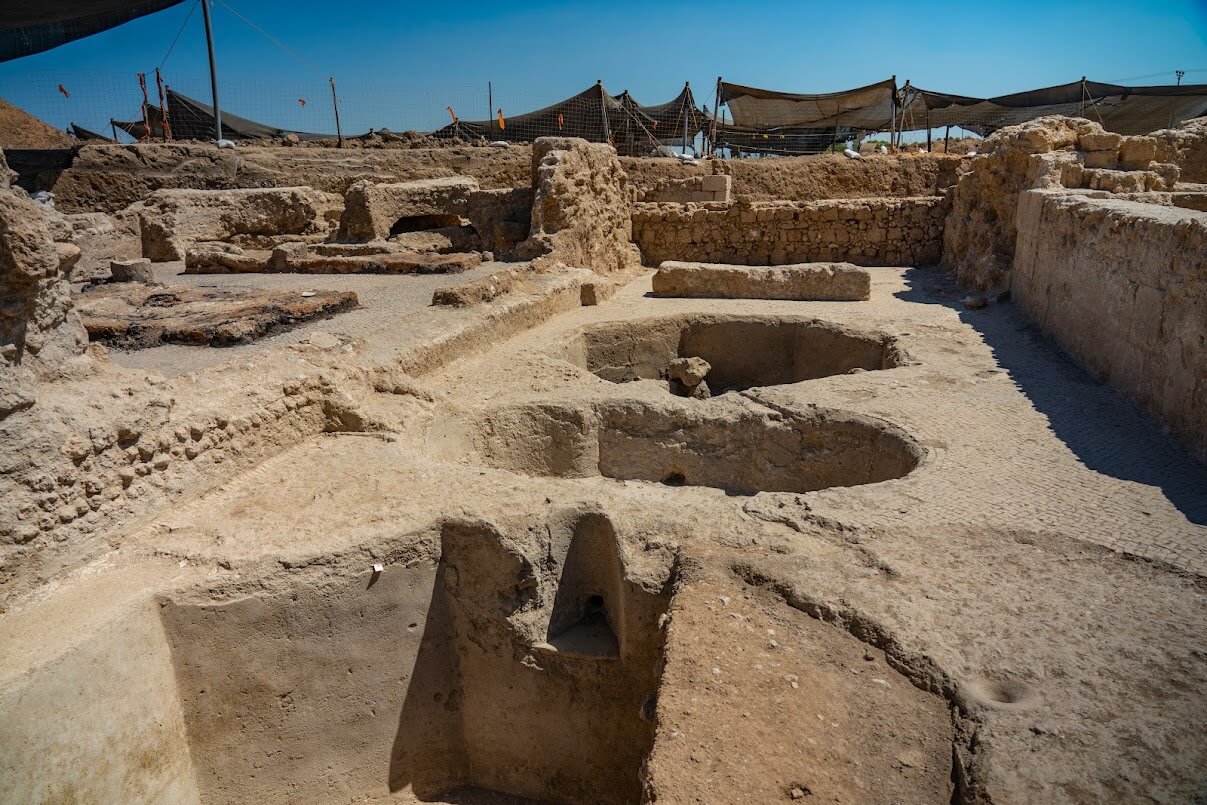A global sensation
Archaeologists: "About 2 million liters of wine were produced here every year." The huge 1500-year-old industrial area was revealed in archaeological excavations by the Antiquities Authority before the expansion of the city, initiated by the Israel Lands Authority

Yavneh was a world wine power about 1500 years ago: a huge and well-planned industrial area from the Byzantine period, in which a very impressive factory for the production of wine - the largest known in the world from the period, was revealed in the city during the last two years. This, in a huge excavation run by the Antiquities Authority as part of the Israel Land Authority's initiative to expand the city. The factory includes five magnificent wine cellars, warehouses for aging the wine and marketing it, kilns for firing the clay jars in which the liquids were stored, tens of thousands of fragments of clay jars and jugs that were found in their entirety, arranged access roads between the facilities, and more.
Drinking wine was very common in ancient times, for children and adults alike. Since the water was not always sterile and tasty, they also used to use wine as a kind of "concentrate" to improve the taste, or as a substitute for drinking water. Each of the revealed gîths covered an area of approximately 225 square meters. Around the treading floor, where they stepped on the grapes with bare feet to squeeze the liquid out of them, cells were built for the fermentation of the wine, and next to them - two pits for collecting the wine, which are octagonal in shape.
According to Dr. Eli Hadad, Liat Nadav-Ziv and Dr. Yochanan (John) Seligman, the directors of the excavation on behalf of the Antiquities Authority, "We were surprised to discover a sophisticated factory here, which was used to produce wine in commercial quantities. The highlight of the gitots are cells ("semi-circular niches") in the shape of an oyster, which decorated the gitots, and indicate the great wealth of the owners of the factory. An approximate calculation of the production capacity of the Ghitots shows that from here about 2 million liters of wine were sold every year..! This is a huge amount even compared to today, and you have to remember that the whole process back then was done manually."

Among the excavations, four large warehouses were discovered, which formed the winery of the factory. The wine is aged in elongated jars, known as 'Gaza jars'. The jars themselves, some of which were discovered in their entirety and tens of thousands more fragments of which were discovered in the excavation, were produced on site in large kilns.
"Gaza and Ashkelon wine" is considered the high-quality wine brand of the ancient world, somewhat similar to the "Jaffa" oranges from Israel, whose name has spread far and wide," the archaeologists explain. "The dishes and wine produced in Yavne gained international fame and reached Europe and Africa. Everyone knew that this was a product from the Land of Israel, and everyone wanted more and more of this goodness. The wine - which was mostly white wine, got its name because it was marketed through the ports of Gaza and Ashkelon. So far, we have known other sites where the wine is made in the lowlands of the south coast, but now, it seems that we have found the main production center of the luxury wine. From here - commercial quantities left for ports, and from there - throughout the Mediterranean basin or the ancient world."
It is interesting to know that in the excavation in Yavne rare goths were uncovered, even more ancient - from the Persian period - about 2300 years ago. "In the Mishnah it is said that after the destruction of Jerusalem, the Jewish leadership wandered to Yavneh, and that the sages of Yavneh lived in a vineyard and studied Torah. "Finding Goths at the site in the Persian period - 2300 years ago, and in the Byzantine period - 1500 years ago, alongside the Talmudic text, may, perhaps, hint at a continuity in the existence of a wine industry at the site over many hundreds of years," say the archaeologists.
According to Eli Escozido, director of the Antiquities Authority, "The Yavneh excavation is a mega-excavation of the Antiquities Authority that extends over dozens of dunams, with the participation of hundreds of workers and dozens of staff members and permanent experts. As a body that seeks to connect the public to the heritage of the land, we involve in the excavation hundreds of teenagers, preparatory school students and the residents of Yavne. Our archaeologists are doing sacred work in uncovering unknown chapters in the history of the land, while working hard in heat and cold. I welcome the cooperation with the Israel Lands Authority and the Municipality of Yavneh, which will allow the presentation of some of the impressive excavation findings to the general public and their integration into an archaeological park."
Jacob Quint, director of the Israel Land Authority, He said that "the treasures hidden in the soil are revealed thanks to the extensive investment of the Israel Land Authority in financing the archaeological excavations in Yavneh. Rami promotes, as part of the umbrella agreement with the Yavne municipality, the construction of a huge project in the area of the Yavne Mizrah Sorek project (Tamel 1049). In the plan, 12,500 units and 450 thousand square meters of commerce and employment will be established. The plan includes the doubling of the railway and construction above a train station. As part of the preliminary work for the development of the plan, the Israel Lands Authority is investing approximately NIS 200 million in the works of the Antiquities Authority, which enable the uncovering of the archaeological finds, their investigation and preservation for the benefit of future generations."
According to the mayor of Yavne, Zvi Gov-Ari: "The impressive finds strengthen the recognition of the importance of the city of Yavne and its glorious past throughout all periods. We determined that the Tel-Yavna site will be preserved and will be an attraction and a touristic and educational center for many visitors in the years to come. The construction plans will be modified and adjusted in such a way that the road that was supposed to pass through the site will be upgraded to a bridge that will allow the continued existence of the site. This type of activity in collaboration with the Antiquities Authority has not been done in other projects in Israel, and this is an opportunity to thank all the parties for their cooperation."
More of the topic in Hayadan:
- "Bring us wine and must"
- A taste of the chemistry of wine
- White wine on the red planet
- Wine and fish sauce - evidence of the culinary preferences of the Romans 2000 years ago was uncovered in Ashkelon
- A 1200-year-old hoard of gold coins was discovered in archaeological excavations by the Israel Antiquities Authority in Yavne
